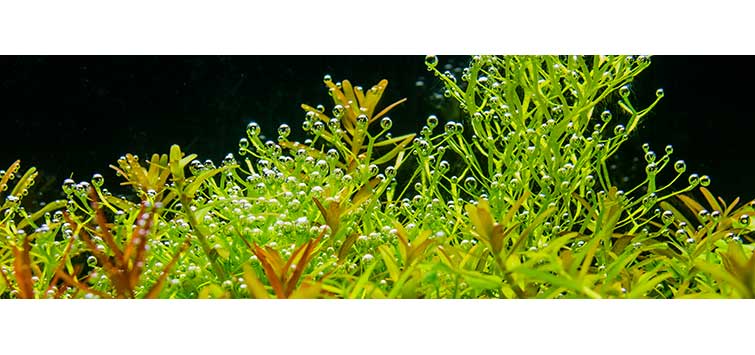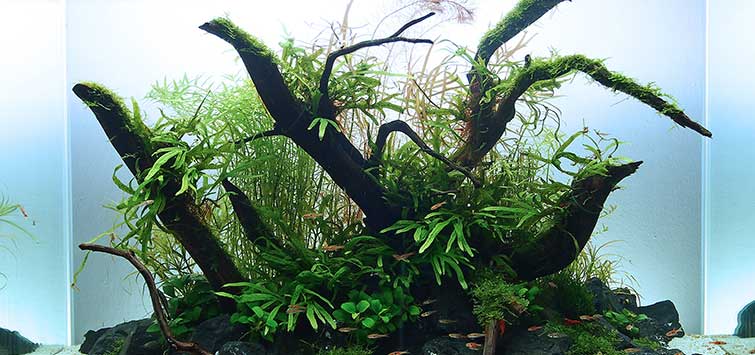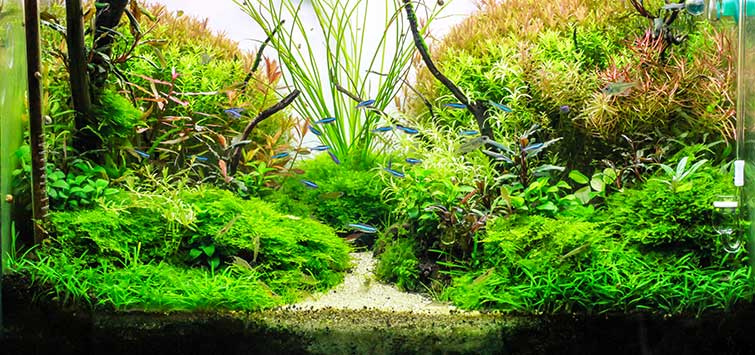Proper CO2 Injection for Light-Loving Plants in the Nature Aquarium
Author: Takashi Amano
The celebrated aquatic plant maestro shares his techniques for using CO2 to obtain optimal plant growth in the Nature Aquarium layout.
Purpose of CO2 Injection
In the Nature Aquarium, CO2 is injected into an aquarium to promote the photosynthesis of aquatic plants. As aquatic plants photosynthesize, the CO2 in the water is depleted quickly, therefore it’s necessary to inject CO2. Aquatic plants photosynthesize actively under bright light, but the process stops when the CO2in the water is depleted. If the pH of the aquarium is measured at this point, it should be quite alkaline.
It would be different if a small amount of aquatic plants are planted in a large aquarium, but when a large amount of aquatic plants are planted densely in an aquarium, as is the case in a Nature Aquarium layout, CO2 injection is essential. Light-loving aquatic plants, such as Riccia and stem plants in particular, do not grow well unless adequate bright light is provided, and an appropriate level of CO2 is injected. In this article, I would like to discuss how to grow light-loving aquatic plants and proper CO2injection volumes.
Before You Start
First we need to provide the substrate, filtration, lighting equipment, and CO2 injection equipment that are appropriate for the size of the aquarium, regardless of whether it will house light-loving plants or shade-loving plants. Please refer to the tank data for various layouts that I have provided in previous articles. Once the growing environment is set up, layout materials such as driftwood and rocks are placed, and aquatic plants are planted.
Light-loving plants photosynthesize vigorously in a bright environment, and they grow relatively quickly. Among the plants that are often used in the Nature Aquarium, the majority of stem plants, Riccia, Glossostigma, hair grass, and Echinodorus species fall into this category of plants. On the other hand, shade-loving plants do not photosynthesize as much, and they tend to grow relatively slowly. Ferns, mosses, and the various Cryptocoryne species belong to this category. While shade-loving plants can be planted in the shade of driftwood and rocks in a layout, light-loving plants need to be planted in an area where they can receive plenty of light.
Step 1: Determine How Much CO2 You Need
Once planting is finished, the aquarium is filled with water and the lighting is turned on, and CO2injection should also begin at this point. Light-loving plants absorb CO2 from the water when they photosynthesize, and they tend to grow better if they are placed in an environment with a somewhat high concentration of CO2 from the start. The rule of thumb for the level of CO2 at which plants photosynthesize vigorously and grow well is approximately 20 mg/l. Although there is a reagent that measures CO2, there is an easier way to determine if the CO2 injection volume is adequate: measure the pH periodically every day. As I mentioned earlier in this article, when aquatic plants photosynthesize and deplete CO2 in water, the pH rises and the water becomes alkaline. On the other hand, when CO2 is injected in water, pH decreases and the water becomes acidic. It is possible to judge the level of CO2 by taking advantage of this opposing nature and balancing pH.
Step 2: Test and Verify
In the Nature Aquarium method, aquariums are aerated at night to prevent hypoxia. The pH generally turns neutral or somewhat alkaline (pH approximately 7.2 to 7.6 using Japanese tap water) over the course of the night, and then the light is turned on and CO2 injection resumes. The photosynthesis of aquatic plants becomes most active 4 to 5 hours after the light is turned on. If the pH of the water at this point is 0.4 to 0.8 lower than the level measured just before the light is turned on (in our case, a pH of approximately 6.8), the amount of CO2 injection is just about appropriate.
You can use a reagent solution kit or pH meter to measure the change in pH level, and adjust the CO2volume using a bubble counter until it approximates the pH change from night to day as detailed above, or use a device employing a reagent that changes color in the presence of varying amounts of CO2 and adjust the bubble counter accordingly. When the CO2 volume is appropriate, Riccia produces air bubbles on the tips of its leaves through photosynthesis and stem plants release air bubbles abundantly. The air bubbles generated by aquatic plants are the sign of vigorous photosynthesis and healthy plant growth.
Step 3: Trim Your Plants
Since light-loving aquatic plants generally grow quickly, repeated trimming becomes necessary. Stem plants are shaped into pretty bushes only by trimming, and Riccia will float due to increasing buoyancy unless it is trimmed somewhat early. In an aquarium planted mainly with these light-loving plants, one must pay careful attention to the CO2 injection volume after trimming.
When the volume of aquatic plants reduces with trimming, the level of photosynthesis reduces as well. Even if the CO2 volume was appropriate before trimming, the same injection rate may produce too much CO2 volume in the trimmed-down aquarium. When this occurs, reduce the injection rate so that the CO2level becomes appropriate again. Then slowly increase the injection rate as the aquatic plants grow, and they will form beautiful bushes again.
See the full article on TFH Digital http://www.tfhdigital.com/tfh/200709/#pg88

.png?h=595&iar=0&w=2781&hash=5FD5E69473BCC22199FBFA2FB71B6033)



